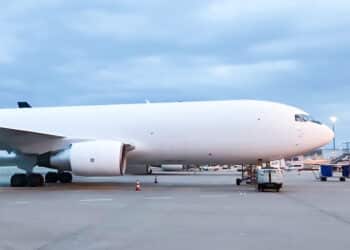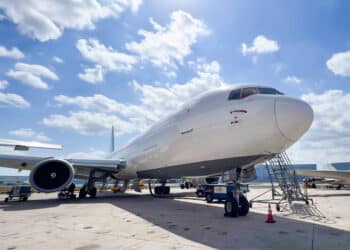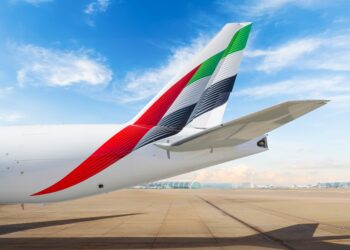Podcast: Astral preps for widebody growth
Listen to the latest episode of ‘Cargo Facts Connect’
Astral Aviation is kicking off the next phase of its fleet expansion with the imminent arrival of its first 767-300 freighter.
With two more 767s potentially following in 2025, Astral has obtained its own aircraft maintenance organization certification and will soon conduct its own C check on its 767-200BDSF for the first time.
“In the past, we’ve always outsourced the C checks, but now we’re going to do it ourselves,” Astral founder and Chief Executive Sanjeev Gadhia says in this week’s episode of “Cargo Facts Connect,” recorded at the IATA World Cargo Symposium 2025 in Dubai this week. “So, we’re really excited, because it’s a C4 check and it’s going to be done in-house in Kenya at the Kenya Airways hangar.”
Astral had expected the 1988-vintage, CF6-powered 767-300BDSF (24146, ex-Amerijet) by the end of 2024 but delays meant the carrier missed the yearend peak season.
“I think the biggest problem that we are all facing right now is the delays,” Gadhia says. “There was a time when those delays were never there, and the delays were there only for the production freighters. Now we are seeing a situation where leased aircraft are also experiencing delays, either because of engine-related issues or avionics.”
The 767-300BDSF is the second new freighter type in the past six months for Astral, which received a 1992-vintage 737-400F (27082, ex-Alaska Airlines) on lease from Avmax in late 2024.
While the global airfreight market tries to navigate the fallout from the trade war, Astral and Kenya are not too concerned.
“I still believe that Africa would really benefit from this whole opportunity, because generally Africa, with the exception of South Africa and two other countries, is at 10%,” Gadhia says, referring to the tariffs that U.S. President Donald Trump recently imposed on goods from countries around the world.
Tune in to this week’s “Cargo Facts Connect” to hear more on Astral as Gadhia speaks with Cargo Facts Editor Jeff Lee at the IATA World Cargo Symposium 2025 in Dubai.
A transcript is available below. This transcript has been generated by software and is being presented as is. Some transcription errors may remain.
Jeff Lee
Hello and welcome to this episode of cargo facts connect, the podcast of cargo facts, the newsletter of record for the air cargo and freighter aircraft industries for over 40 years. I’m Jeff Lee, editor of cargo facts and it’s Friday, the 18th of April. Another 767 freighter is making its way to Africa, with Astral Aviation taking delivery of its first 767-300BDSF. At this week’s IATA World Cargo Symposium in Dubai, Astral founder and CEO Sanjeev Gadhia shared the good news with me and we caught up on the growth of his freighter fleet, Astral’s maintenance capabilities and the trade war. Take a listen.
Jeff Lee
So yes, you finally have your 767
Sanjeev Gadhia
yes, we finally have the 767, after six months. MSN, 24146, was previously operated by a marriage, yes. And now we have taken this aircraft on a long term lease from a company called Flight lease. Yes,
Jeff Lee
it’s flight lease slash Specter. Slash,
Sanjeev Gadhia
Yes, exactly. So the aircraft we expect will ferry to Kenya by Friday. There is still a demo flight that has to be done by today, our pilots are already in the US to ferry. Aircraft is already been de registered.
Jeff Lee
Yes, I saw that. I just checked.
Sanjeev Gadhia
Brilliant. So, so this is the first 767, 300 that will join our fleet. Again, long forward you. But we know that as soon as this aircraft comes in and again, this will be registered in Kenya.
Jeff Lee
First 767, 300 in Kenya too, right?
Sanjeev Gadhia
Yes. First 767, 300 in Kenya and we are also planning to acquire a second 767, 300 from flight leads at this moment in time. We don’t have the MSN number, but we really believe that once we have the 276 7300 we should be fairly stable. Of course, we still have the 767 200 and then we have a second 767 200 which will join the fleet. So I think from a fleet plan of from a fleet point of view, we will be quite happy with 2 767, 200s and 2 767 300s because next year we’ll be focusing on the A 330 300s because this is part of our strategic expansion. And also with the A 330 300 it will also give us some leeway for the triple seven, which eventually,
Jeff Lee
eventually,
Sanjeev Gadhia
which eventually will come. So I think the fleet would be very simple. But of course, the 330 300 will not be on our Kenya AOC, because the Kenya AOC is strictly for the Boeing platform. So for the Kenya AOC, of course it will be the 737 767 triple seven. So for the A 330 300 we are still looking at a couple of options for where we will host it. So this is really more or less what’s happening. The 737 400 is doing very well. We are in talks with flight links for a 737, 700 which we believe would be much better than the 800 because of the range.
Jeff Lee
So this is, I guess, yeah, we can call it a very niche freighter, 700 Yes, it’s, but it’s, yeah, it’s interesting. And for certain markets, it
Sanjeev Gadhia
does for certain markets, which needs a range. I believe the 700 you know, the problem with Africa is such a big continent. When you look at distances like Cape Town, to Alexandria, that’s 10 hours. That’s south to north is 10 hours. East to west of Africa is almost 12 hours. So when you have that kind of a range, it would really help.
Jeff Lee
Because it’s maybe not enough for a wide body printer, I guess.
Sanjeev Gadhia
Yes, yes. I believe the African market is still has the best opportunity. And of course, operating from our hub in Nairobi, it also limits us if you do not have a long range aircraft. So we want to make sure that first we get the wide body fleet strategy in place, and then focus on the narrow body.
Jeff Lee
So when do you want the second 767, 300 by?
Sanjeev Gadhia
We’ve been expecting that if everything goes well, we should be getting it by August. But I think the biggest problem that we are all facing right now is the delays. So from the time you book an aircraft, you know, there was a time those delays were never there, and the delays were there only for the production freighters. Now we are seeing the situation where leased aircrafts are also experiencing delays. Either it’s because of engine related issues, avionics, which is so important, because what we’ve actually seen is a lot of the wide body aircrafts from the US, the avionics are not in par with what is required for operations out of China, for example. Right? So when you have an us operator operating with limited avionics for the US and South America, those avionics need to be upgraded for it to meet the requirements for China, Australia, the Middle East. So this is where sometimes we, as the lessee, do not want to touch the aircraft until the avionics are upgraded, because those are very significant costs.
Jeff Lee
Right, and those parts are also being delayed.
Sanjeev Gadhia
Exactly. So that’s, that’s where the real delay so for example, MSN, 24146, was actually booked in August 2024 and I feel so embarrassed because sometimes they’ll be having the interviews we tell you about our fleet plan that you must be thinking, but where’s the aircraft now? So this is, this is how painful it can get. Because you can imagine, we missed that bull run in October to December. Yeah? So, yeah, it can really be painful to get an aircraft in the low season where we could have really, if we had it at the right time, it would have just been so much beneficial.
Jeff Lee
Yeah, I mean, when you’re doing the planning these days, it’s like you kind of have to do it the opposite way, to take into account the delay double the time period. What about the second 200?
Sanjeev Gadhia
So we already have done we’ve already done an assessment of the 200 the 200 was also booked last year. So this is also a part of our plan. But then we have to accelerate the 300 and slow down on the 200 because it’s the same, it’s the same lessor. So we’re very, very confident that now we’ve taken the 300 will settle down with it. Then the focus before we get the next 300 is to get a 200 in between. So, you know, we have to plan it out. Because, of course, growing maintenance are all big challenges. And one thing which is quite important is our existing 767 200 we will actually be doing our first C check as Astral. So we have an amo. In the past, we’ve always outsourced the c checks, but now we’re going to do it ourselves. So we’re really excited, because it’s a c4 check, it’s going to be done in hours in Kenya with at the Kenya Airways hangar. So we’re also building our own capacity to do our own maintenance, which is so important, because we just, you know, when we used to outsource it, it just used to be so difficult, but now we’re going to be in charge of our own.
Jeff Lee
Yeah, you need, need to be in control of your own. And especially, it makes sense, especially you’re going to be, hopefully you have 4 767s by the end of this year.
Sanjeev Gadhia
Yes, yes. And then, of course, we had, we give our feedback on the tariffs. I still believe that Africa would really benefit from this whole opportunity, because generally Africa, with exception of South Africa and two other countries, are at 10% there’s only one thing to remember is that currently Africa has as a preferential trade agreement with the US called AGOA, which allows African exports to enter the US market at 0% so there’s very strong possibility that that will not be renewed, because that’s almost 15 years old. But even from zero to 10% is still not bad compared to are they doing other Yes, yeah. But again, Africa is still not being seen positively, because. Of what’s been happening on the geopolitical side, we’re actually hopeful that we will actually get a preferential tariff, especially for our textile and apparel exports when it comes to road flowers and the perishables, I think the US is not such an important market, because our focus is always with the Middle East in Europe, whereas the US buys its flowers from South America. So we’re not really concerned. But you know, their textiles and their parents market is dependent on the US. For example, a small country in South Africa, Lesotho, manufactures Levi’s jeans for South Africa. I’m sorry for the US, they were hit with a 50% so you can imagine how it will affect the country. But but in all honesty, I feel that Africa will still do well, even with the 10% they can still be able to have a very competitive advantage. And Ethiopia and Kenya will actually have a very, very good opportunity to take advantage of the high tariffs if, after the 90 days are over, that we will have to wait at launch.
Jeff Lee
Yeah, I think everyone’s just waiting to see what exactly will Jay what will become real or change, or, you know, it’s exactly, it’s yes, interesting times, but uncertain times, uncertain times.
Sanjeev Gadhia
And, of course, yesterday, it was really good to listen to the data. Yeah, there’s a lot of speculation. I just feel that it’s too early to speculate, yeah, about what’s going to happen, what’s going to be the impact on the air cargo industry. I think probably by the time we’re getting to Munich, we will be in a better idea, because I think everybody’s just panicking. It’s just better to just cow just sort of, you know, Wither the stove. And of course, I know how difficult it is for airlines who’ve got 3040, aircrafts a flight between the US. I’m sure it’s easy for me to see that, but I’m sure they must be having sleepless nights
Jeff Lee
as well. Great looking forward to seeing your seven, six, sevens come on board, and we will see you in Istanbul,
Sanjeev Gadhia
looking forward to that.
Jeff Lee
Great.
Jeff Lee
That was Sanjeev Gadhia, founder and CEO of Astral Aviation, talking with me at the IATA World Cargo Symposium in Dubai this week. And that’s all the time we have today. For more coverage of the freighter aircraft and AAM market, visit cargofacts.com. Thank you very much for tuning in, and join us again next time.
Subscribe to Cargo Facts Connect on iTunes or Spotify, or download the episode on Transistor.
Register now for Cargo Facts EMEA, an essential regional event for industry stakeholders, on May 6-8 at the Shangri-La Bosphorus in Turkey.




